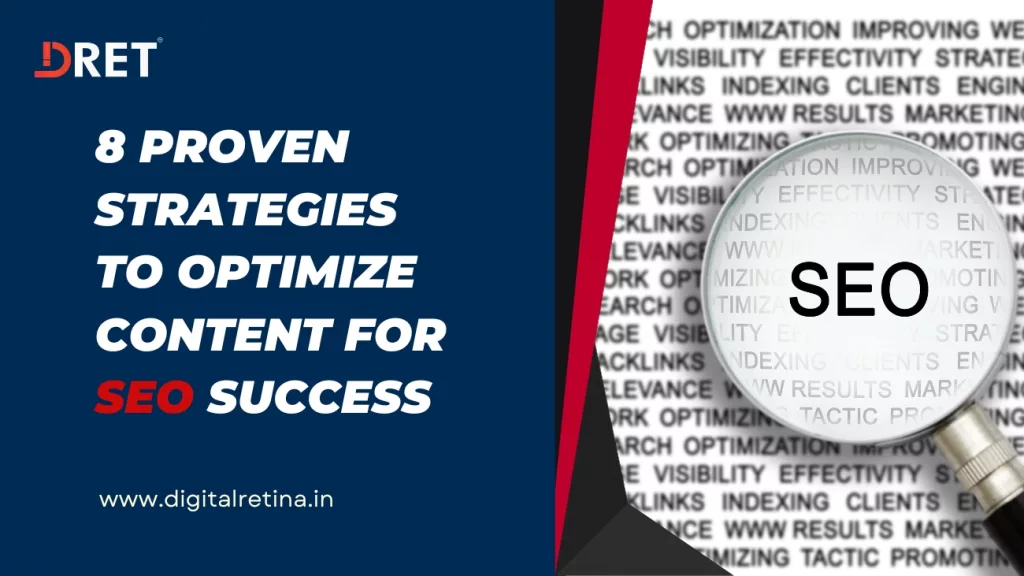
8 Proven Strategies to Optimize Content for SEO Success
- By digitalretina
- No Comments
- Post Views: 211

Introduction
In the vast world of digital marketing, optimizing your content for SEO (Search Engine Optimization) is the key to ensuring your website gets the visibility it deserves. Whether you’re a seasoned pro or just starting your journey, this guide will equip you with eight proven strategies to make your content shine in the eyes of search engines and, ultimately, your target audience.
1. Understand Your Audience
Understanding your audience is a multifaceted process. It goes beyond knowing basic demographic information. You must delve deep into their needs, preferences, pain points, and online behaviors. This understanding forms the cornerstone of your content strategy. By comprehending your audience, you can create content that resonates with them on a personal level. You’ll be able to address their questions, alleviate their concerns, and provide solutions to their problems effectively.
For example, if you’re in the health and fitness niche, understanding your audience might involve knowing their specific fitness goals, dietary preferences, and exercise habits. Armed with this knowledge, you can tailor your content to provide valuable insights and practical tips that genuinely cater to their needs. This level of personalization not only attracts and retains visitors but also encourages them to engage further with your website.
2. Quality Content is King
The age-old adage “Content is King” still rings true in the realm of SEO. The bedrock of a thriving SEO strategy lies in top-notch content.. It’s not just about inserting keywords; it’s about offering something valuable to your audience.
Quality content should be well-researched, informative, engaging, and well-structured. It must answer questions, provide solutions, or entertain readers. Your content should offer a unique perspective or insights that set you apart as an authority in your field. Valuable content builds trust and authority, encouraging users to stay longer on your site, engage with your material, and ultimately convert into customers or loyal readers.
To achieve this, focus on delivering well-crafted, informative, and engaging content. Avoid duplicate or low-quality content, and aim to be the go-to source for your audience’s information needs. This approach not only attracts organic traffic but also keeps users coming back for more.
3. Keyword Research
Keyword research is the compass guiding your content through the vast wilderness of the internet. It involves identifying the specific terms and phrases your target audience is actively searching for. These keywords serve as bridges connecting your content to potential readers and customers.
For instance, if you’re a tech blog, understanding which keywords are trending in your niche can help you create content that aligns with your audience’s interests. You may come across the fact that “Best Technical SEO Tools” is a well-liked keyword. By naturally incorporating this keyword into your content, you make it more discoverable by search engines and relevant to your audience.
Effective keyword research also includes long-tail keywords, which are more specific phrases. They may have lower search volumes, but they often convert better because they precisely match what users are seeking. By blending a mix of high-volume keywords and strategically chosen long-tail keywords, you can cast a wider net and draw in both general and highly targeted traffic.
4. On-Page SEO Optimization
On-page SEO optimization involves ensuring that your content is not only valuable but also easily discoverable by search engines. Your main keyword, in this case, “optimize content for SEO,” should be naturally integrated into your content. It’s critical to place it strategically in areas such as the title, headings, and throughout the body text. This placement helps search engines understand the primary focus of your content.
Additionally, LSI (Latent Semantic Indexing) keywords, such as “Best Technical SEO Tools“ and “Core Web Vitals for Technical SEO,” should be used thoughtfully. These related keywords support your main keyword and provide context for your content, reinforcing its relevance to search engines and users alike.
Proper on-page SEO also includes optimizing meta tags, like title tags and meta descriptions, as well as using header tags (H1, H2, H3) to structure your content logically. This not only improves SEO but also enhances the user experience by making your content more readable and scannable.
5. High-Quality Backlinks
High-quality backlinks are like trusted endorsements from authoritative sources in your niche. Search engines view them as votes of confidence in your content. Building a network of such backlinks can significantly enhance your website’s visibility and authority.
Reaching out to reputable websites in your industry for collaboration can lead to guest posts, shared content, or backlinks. When high-authority websites link back to your content, it’s a strong signal to search engines that your site is trustworthy and valuable.
Creating link-worthy content is equally important. By crafting informative, shareable, and engaging content, you naturally increase the likelihood of others in your industry linking to your work. High-quality backlinks are an essential element of SEO that should be nurtured continually to strengthen your website’s reputation.
6. Optimize for Mobile Devices
With the majority of internet traffic originating from mobile devices, optimizing your website for mobile is not an option; it’s a necessity. Mobile optimization ensures that your site is not only responsive but provides an excellent user experience on smartphones and tablets.
To achieve this, use responsive web design, which automatically adjusts your site’s layout to fit various screen sizes. Ensure that images and other media are optimized for mobile loading speeds, which is crucial for retaining visitors. Running tests on different devices and screen sizes can help you identify and rectify any mobile compatibility issues.
Optimizing for mobile goes beyond SEO; it directly impacts user satisfaction. A mobile-friendly website makes navigation easy, text legible, and actions straightforward, leading to higher engagement and conversion rates. Additionally, search engines favor mobile-friendly websites, which can positively influence your rankings.
7. Speed Matters
Page loading speed is a critical factor in SEO success. Users expect web pages to load quickly, and search engines consider this aspect when ranking websites. A slow website can lead to high bounce rates and poor user experiences, which can harm your SEO efforts.
To optimize your content for SEO, you must work on improving your website’s loading speed. This involves various strategies, such as optimizing images, minimizing code, and utilizing content delivery networks (CDNs). Compressing images, for example, reduces their file size without sacrificing quality, leading to faster loading times.
Minimizing code by removing unnecessary elements and utilizing efficient coding practices can also significantly enhance your site’s performance. Content delivery networks distribute your website’s content across multiple servers, reducing the physical distance data must travel, resulting in faster loading times for users across the globe.
Speed matters because it not only improves your SEO but also enhances user satisfaction and encourages users to stay longer on your site, explore your content, and possibly convert into customers or subscribers.
8. Core Web Vitals for Technical SEO
Google’s Core Web Vitals are an essential part of technical SEO. These metrics measure the real-world user experience on your website, and they include Loading Performance, Interactivity, and Visual Stability.
Loading Performance evaluates how quickly your website’s content loads. A fast-loading website ensures users can access information promptly, reducing bounce rates and improving user satisfaction.
Interactivity measures the responsiveness of your website. Users should be able to interact with your content, such as clicking buttons or entering data, without frustrating delays.
Visual Stability assesses how stable your website’s layout is while it loads. Unexpected shifts in content can be disorienting for users and may lead to negative experiences.
Focusing on these Core Web Vitals helps improve the technical SEO of your website. A fast, responsive, and visually stable site enhances user satisfaction and encourages them to explore your content further. In turn, this positively impacts your search engine rankings, making your content more accessible to your target audience.
Conclusion
Optimizing your content for SEO is an ongoing process that requires time and effort. However, the results are well worth it. By understanding your audience, creating high-quality content, conducting keyword research, optimizing for mobile devices, building backlinks, ensuring fast loading speeds, and focusing on Core Web Vitals, you can take your content to the next level in terms of SEO.
At Digital Retina, we understand the importance of SEO in the ever-evolving digital landscape. Our team of experts is ready to help you implement these strategies and more to maximize your website’s potential. Contact us today to learn how we can partner with you for SEO success.
In conclusion, mastering the art of content optimization for SEO is a dynamic and evolving journey. By implementing these proven strategies and keeping pace with the latest trends, you’ll not only improve your website’s search engine rankings but also provide valuable content to your audience. Remember, SEO is not about tricks or shortcuts; it’s about delivering the best user experience and the most valuable information, and that’s a goal worth pursuing.
digitalretina

Jayant Singh
Meet Jayant Singh, the visionary CEO of Digital Retina. With over 8 years of expertise in digital marketing and brand growth strategies, Jayant's leadership has led to the successful transformation of numerous businesses. His knack for innovative solutions continues to shape the digital marketing landscape.


Comprehensive Guide to PPC Strategies: How to Make the Most of Your Paid Advertising

